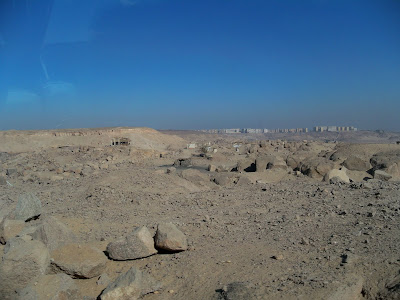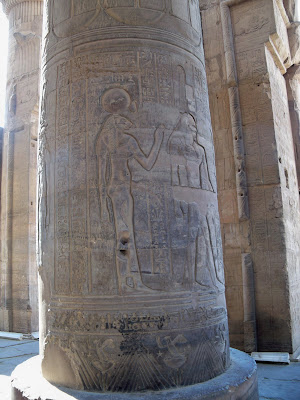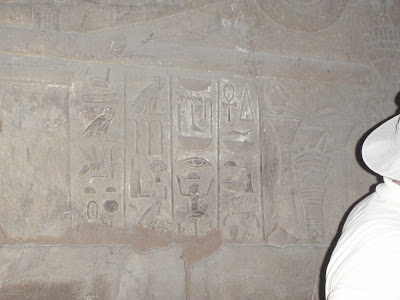Dalia gets us up early to be the first out to New Kalabsha to see 4 structures. They have beautiful reliefs and columns in them.
 spying a bird with the Aswan High Dam behind,
spying a bird with the Aswan High Dam behind, taking a boat out to New Kalabsha,
taking a boat out to New Kalabsha, above is the Lotus Flower sculpture, the Kiosk of Kertassi is below,
above is the Lotus Flower sculpture, the Kiosk of Kertassi is below, The Temple of Kalabsha was built about 30 bc during the early Roman era as a tribute to Mandulis, a lower Nubian sun god. There is a stair case leading to the roof where we had great views of the area.
The Temple of Kalabsha was built about 30 bc during the early Roman era as a tribute to Mandulis, a lower Nubian sun god. There is a stair case leading to the roof where we had great views of the area.


 The Nubian god Mandulis,
The Nubian god Mandulis,








 The next three pictures are of the kiosk of Kertassi,
The next three pictures are of the kiosk of Kertassi,
 two heads of Hathor on the columns on the Kiosk of Kertassi,
two heads of Hathor on the columns on the Kiosk of Kertassi, Below is Gerf Hussein originally known as Per Ptah "House of Ptah" is dedicated to Ramesses II,
Below is Gerf Hussein originally known as Per Ptah "House of Ptah" is dedicated to Ramesses II,
 Front of The Temple of Beit el-Wali is above,
Front of The Temple of Beit el-Wali is above,

 The Temple of Beit el-Wali is a rock cut ancient Egyptian temple built by Ramesses II and dedicated to Amun Re, re Horakhti, Khnum and Anuket. There is a lot of color remaining in the inner part of this temple.
The Temple of Beit el-Wali is a rock cut ancient Egyptian temple built by Ramesses II and dedicated to Amun Re, re Horakhti, Khnum and Anuket. There is a lot of color remaining in the inner part of this temple. Dalia explaining the scenes to us,
Dalia explaining the scenes to us,





 the sanctuary contains 3 rock cut images of Amun, Ptah, and Ramesses II.
the sanctuary contains 3 rock cut images of Amun, Ptah, and Ramesses II.


 last looks at Lake Nasser before heading north,
last looks at Lake Nasser before heading north, There are a number of well known quarries in Aswan where red, grey, and black granite were mined from during ancient times. Many unfinished objects can still be seen,
There are a number of well known quarries in Aswan where red, grey, and black granite were mined from during ancient times. Many unfinished objects can still be seen, Aswan is also known for it's production of Egyptian cotton, the scarves are beautiful,
Aswan is also known for it's production of Egyptian cotton, the scarves are beautiful, very ornate galabeyas, the traditional Egyptian garment which are mostly plain and worn by men and women.
very ornate galabeyas, the traditional Egyptian garment which are mostly plain and worn by men and women.  houses are built right around all of the huge granite rocks,
houses are built right around all of the huge granite rocks, huge piles of rocks were everywhere,
huge piles of rocks were everywhere, heading north along the Nile,
heading north along the Nile, you can see the tip of Elephantine, an island in the Nile. It may have received its name because it was a trading place for ivory. It was known to the ancient Egyptians as Abu. It's border is right at the Tropic of Cancer, the sun can appear directly overhead at noon and then appears to reverse directions and turn back at the solstices. There is an important granite quarry on the island. On the left bank of Aswan is a Necropolis where many nobles were entombed,
you can see the tip of Elephantine, an island in the Nile. It may have received its name because it was a trading place for ivory. It was known to the ancient Egyptians as Abu. It's border is right at the Tropic of Cancer, the sun can appear directly overhead at noon and then appears to reverse directions and turn back at the solstices. There is an important granite quarry on the island. On the left bank of Aswan is a Necropolis where many nobles were entombed,

 Nubian villages, many houses are left without roofs because they receive little rain, the floors are dirt, as are all the streets,
Nubian villages, many houses are left without roofs because they receive little rain, the floors are dirt, as are all the streets,






 We stopped at Kom Ombo, an agriculture town known for the Temple of Kom Ombo. It was originally an Egyptian city called Nubt meaning City of Gold.
We stopped at Kom Ombo, an agriculture town known for the Temple of Kom Ombo. It was originally an Egyptian city called Nubt meaning City of Gold. old resident structures of mud brick,
old resident structures of mud brick, The Temple of Kom Ombo is spectacular. It is a double temple built during the Ptolemaic dynasty in 180 bc. Much of it was destroyed during earthquakes,
The Temple of Kom Ombo is spectacular. It is a double temple built during the Ptolemaic dynasty in 180 bc. Much of it was destroyed during earthquakes,
 there are duplicate sets of courts, halls, sanctuaries, and rooms-one side dedicated to falcon god Haroeris or Horus the Elder and the other side dedicated to the crocodile god Sobek-the god of fertility and creator of the world with Hathor and khonsu.
there are duplicate sets of courts, halls, sanctuaries, and rooms-one side dedicated to falcon god Haroeris or Horus the Elder and the other side dedicated to the crocodile god Sobek-the god of fertility and creator of the world with Hathor and khonsu.
 view of the Nile,
view of the Nile,
 entry for one side of the temple,
entry for one side of the temple,
 entry for the other side,
entry for the other side,



 the tops of the columns are papyrus shaped,
the tops of the columns are papyrus shaped,

 Owen standing in front of a wall-the carved figures are the size he is,
Owen standing in front of a wall-the carved figures are the size he is,
 he is pointing out the difference between the two different types of carvings-this one he says is more difficult because it is raised and not carved down in, he also figured out which side was dedicated to Sobek and which side was for Horus.
he is pointing out the difference between the two different types of carvings-this one he says is more difficult because it is raised and not carved down in, he also figured out which side was dedicated to Sobek and which side was for Horus. I like the little feet along what is now a step,
I like the little feet along what is now a step,
 this would have been the sanctuary,
this would have been the sanctuary,


 the god Horus is the second figure from the right, the kids are pretty good at picking him out now
the god Horus is the second figure from the right, the kids are pretty good at picking him out now



 the fields around the temple,
the fields around the temple, the sugar cane trucks lined up to go into the processing plant,
the sugar cane trucks lined up to go into the processing plant, graveyard,
graveyard, more Nubian houses,
more Nubian houses,



 Inside of the Winter Palace in Luxor. It was built in 1886 as an 86 room hotel. I couldn't find anything telling me this was ever anything but a hotel,
Inside of the Winter Palace in Luxor. It was built in 1886 as an 86 room hotel. I couldn't find anything telling me this was ever anything but a hotel, the gardens are beautiful,
the gardens are beautiful, we checked into our rooms and headed off...
we checked into our rooms and headed off...
 to Luxor...Luxor, still part of Upper Egypt (in the south) was the ancient Egyptian city of Thebes, the great capital of Egypt during the New Kingdom. It was also the glorious city of the god Amon Ra.
to Luxor...Luxor, still part of Upper Egypt (in the south) was the ancient Egyptian city of Thebes, the great capital of Egypt during the New Kingdom. It was also the glorious city of the god Amon Ra. The Luxor Temple is a large Ancient Egyptian temple complex on the east bank of the Nile founded in 1400 bc. It was known as the Southern Sanctuary and dedicated to the Theban Triad of Amun, Mut, and Chonus. It was the focus of the annual Opet Festival in which the statue of Amun was paraded down the Nile from nearby Karnak Temple to stay with his consort Mut in a celebration of fertility. The earliest part of the temple was by Hatshepsut and continued by Tuthmosis III, Amenhotep III, and later Ramesses II. At the rear is a granite shire dedicated to Alexander the Great. For 4,000 years the temple was burried beneath the streets and houses of Luxor.
The Luxor Temple is a large Ancient Egyptian temple complex on the east bank of the Nile founded in 1400 bc. It was known as the Southern Sanctuary and dedicated to the Theban Triad of Amun, Mut, and Chonus. It was the focus of the annual Opet Festival in which the statue of Amun was paraded down the Nile from nearby Karnak Temple to stay with his consort Mut in a celebration of fertility. The earliest part of the temple was by Hatshepsut and continued by Tuthmosis III, Amenhotep III, and later Ramesses II. At the rear is a granite shire dedicated to Alexander the Great. For 4,000 years the temple was burried beneath the streets and houses of Luxor. hundreds of sphinxes line the road to Karnak,
hundreds of sphinxes line the road to Karnak, they are still excavating the avenue of human headed sphinxes that goes over 1 1/2 miles to Karnak,
they are still excavating the avenue of human headed sphinxes that goes over 1 1/2 miles to Karnak, the entrance once had two red granite obelisks, one is now in the center of the Place de la Concorde in Paris,
the entrance once had two red granite obelisks, one is now in the center of the Place de la Concorde in Paris, the massive seated statues of Ramesses II guard the huge gateway (pylon),
the massive seated statues of Ramesses II guard the huge gateway (pylon), the Feast of Amun took place around the middle of the inundation period and lasted 24 days, the sacred boats of the Theban triad were brought from Karnak and carried into the temple of Luxor, there would have been a great procession with musicians, dancers, priests, soldiers, and the chariots of the king, they would have been received at Luxor Temple by the priestesses with flowers and offerings,
the Feast of Amun took place around the middle of the inundation period and lasted 24 days, the sacred boats of the Theban triad were brought from Karnak and carried into the temple of Luxor, there would have been a great procession with musicians, dancers, priests, soldiers, and the chariots of the king, they would have been received at Luxor Temple by the priestesses with flowers and offerings, above and the following pictures are of the great Court of Ramesses II, it contains 74 papyrus columns with bud capitals,
above and the following pictures are of the great Court of Ramesses II, it contains 74 papyrus columns with bud capitals,





 mosque that once sat at street level,
mosque that once sat at street level,




 Mosque of al-Hajjaj that was at street level,
Mosque of al-Hajjaj that was at street level,

















 Erica collecting rocks,
Erica collecting rocks, the Colonnade of Amenhotep III has seven pairs of 52 foot high open flower papyrus columns,
the Colonnade of Amenhotep III has seven pairs of 52 foot high open flower papyrus columns,
 This was done during a Coptic Christian period. Christianity was the major religion here until the mid 6th century during the Muslim conquest. There is an estimated 15 million Copts in Egypt today-roughly 10-20% of the population (holding roughly 50% of the country's wealth)- and is the largest and oldest Christian community in Africa and the Middle East. They speak an Egyptian language spoken during the Roman era. Christianity was brought to Egypt in 42 ad by Saint Mark. There are Coptic writings of the New Testament dating to the 2nd century. The oldest Christian school is in Alexandria dating to 190 ad. What is really interesting is Copt literally means "people of Egypt" or "Egyptians." In 641 ad when the Arabs invaded Egypt they required all to convert to Islam. Those who did not were heavily taxed and called Copts-referring to them exclusively as Egyptian natives. They have a strong sense about their Egyptian pre-Arab identity. Coptic remained the spoken language of Egyptians until it was slowly replaced by Arabic around the 17th century. Dalia told us about her Coptic friend that jokes with her saying his family must have been richer than her because his could afford to pay the tax for not being Muslim but her's couldn't so they had to convert. There are about 4 million Copts living outside of Egypt. I was so surprised to see a Coptic church in Hawaii.
This was done during a Coptic Christian period. Christianity was the major religion here until the mid 6th century during the Muslim conquest. There is an estimated 15 million Copts in Egypt today-roughly 10-20% of the population (holding roughly 50% of the country's wealth)- and is the largest and oldest Christian community in Africa and the Middle East. They speak an Egyptian language spoken during the Roman era. Christianity was brought to Egypt in 42 ad by Saint Mark. There are Coptic writings of the New Testament dating to the 2nd century. The oldest Christian school is in Alexandria dating to 190 ad. What is really interesting is Copt literally means "people of Egypt" or "Egyptians." In 641 ad when the Arabs invaded Egypt they required all to convert to Islam. Those who did not were heavily taxed and called Copts-referring to them exclusively as Egyptian natives. They have a strong sense about their Egyptian pre-Arab identity. Coptic remained the spoken language of Egyptians until it was slowly replaced by Arabic around the 17th century. Dalia told us about her Coptic friend that jokes with her saying his family must have been richer than her because his could afford to pay the tax for not being Muslim but her's couldn't so they had to convert. There are about 4 million Copts living outside of Egypt. I was so surprised to see a Coptic church in Hawaii.

 the Chamber of the Divine King was plastered and painted with scenes of Roman officials, figures of Diocletian, Maximilian and two Caesars are in the apse,
the Chamber of the Divine King was plastered and painted with scenes of Roman officials, figures of Diocletian, Maximilian and two Caesars are in the apse,


 reliefs on the walls bear the names of Tutankhamun, Horemheb, Seti I, Ramesses II and Set II,
reliefs on the walls bear the names of Tutankhamun, Horemheb, Seti I, Ramesses II and Set II,






 the Court of Amonhotep III has double rows of papyrus columns of three sides, the court leads to the Hypostyle Hall which has 32 papyrus columns in 4 rows of 8, there is antechamber leading to the birth room, the chapel of Alexander the Great and the sanctuary,
the Court of Amonhotep III has double rows of papyrus columns of three sides, the court leads to the Hypostyle Hall which has 32 papyrus columns in 4 rows of 8, there is antechamber leading to the birth room, the chapel of Alexander the Great and the sanctuary, the Hypostyle Hall, also known as the hall of appearance,
the Hypostyle Hall, also known as the hall of appearance,










 after seeing the Luxor Temple we went to see glass blown perfume bottles and learn about perfume oils,
after seeing the Luxor Temple we went to see glass blown perfume bottles and learn about perfume oils, at one point the guy brought out myrrh and I said out loud to myself that it was for death-thinking that's what they used when mummifying ancient Egyptians. Well the guy said, "no! it was one of the three gifts given to Jesus with gold and frankincense." I say, "yes, it was to signify His death, gold means his Kingship and frankincense for His priesthood." The guy says "no" again, "they wouldn't give gifts of death they were for the prophet," so I gear up to go all out, "Jesus wasn't a just a prophet, He is G--" wham-o...Erik's elbow right in my ribs...
at one point the guy brought out myrrh and I said out loud to myself that it was for death-thinking that's what they used when mummifying ancient Egyptians. Well the guy said, "no! it was one of the three gifts given to Jesus with gold and frankincense." I say, "yes, it was to signify His death, gold means his Kingship and frankincense for His priesthood." The guy says "no" again, "they wouldn't give gifts of death they were for the prophet," so I gear up to go all out, "Jesus wasn't a just a prophet, He is G--" wham-o...Erik's elbow right in my ribs...
No comments:
Post a Comment